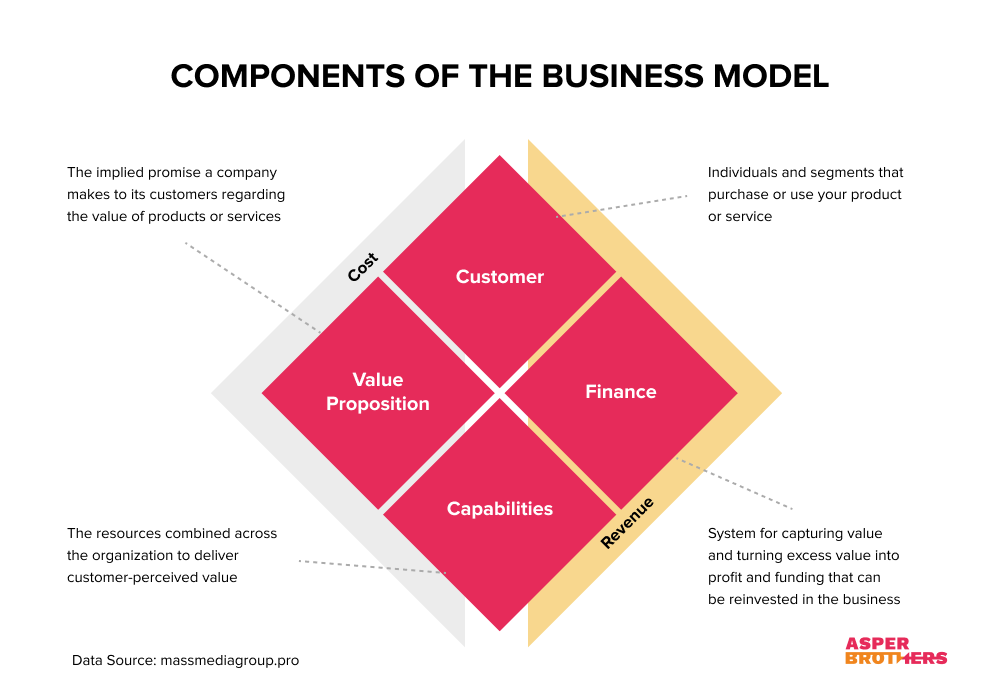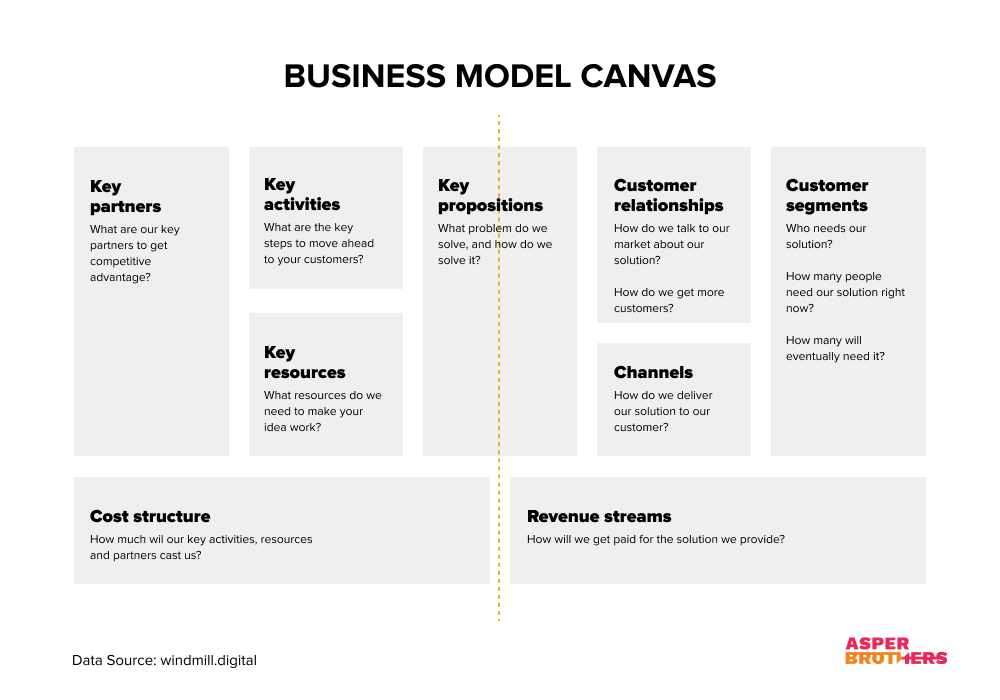Startup Bootstrapping – Self-Funding Advantages and Disadvantages
In today's world, funding new business initiatives, especially in the technology industry, has many forms. One method is self-funding...

Yet, amongst them all, choosing the right business model stands as a momentous turning point.
This choice, often made in the midst of ideation and strategizing, serves as the very backbone of the startup, influencing its trajectory and ultimate success. While innovation and passion fuel a startup’s engine, it’s the business model that steers its course.
But what precisely is a business model? It may seem like an abstract or nebulous term, especially to those new to the entrepreneurial world, yet its significance cannot be understated. Beyond informing your business’s core objectives and strategies, a robust business model facilitates resilience. It equips a company to pivot, adapt, and evolve in response to changing market dynamics and unforeseen challenges
So, as we delve into the intricacies of business models, remember: it’s not just about profitability but shaping the very destiny of your startup.
In this article:
In essence, a business model is a blueprint for how a company creates, delivers, and captures value. It is a strategic framework that defines the methodology an enterprise uses to operate and make money.
However, it is far more than just a profit-making strategy; a business model encapsulates the entire spectrum of a company’s activities and concerns every department – from marketing to operations to the relationships with suppliers and customers.
A business model is predicated on addressing key questions: Who are our customers? What value are we providing? How do we provide that value? How do we monetize the value we provide?
The answers to these questions not only establish the basis of your business strategy but also allow you to discern your unique value proposition in the marketplace.

The diagram shows the components of any business model. Keep them in mind, as they will come in handy in the following sections.
Your chosen business model plays a pivotal role in your venture’s success, as it acts as the blueprint for how your startup will generate revenue, manage costs, and deliver value to customers. From subscription models that offer recurring revenue to freemium models that leverage free offerings to attract a broader audience, there are numerous paths to profitability.
In this section, we’ll explore 10 prominent business models that have been instrumental in the success of many startups. By understanding the mechanics, advantages, and potential challenges of each, you can make an informed decision on the best fit for your unique venture.
The subscription model is a business approach that charges customers a recurring fee, typically monthly or annually, to access a product or service. This model is designed to develop long-term relationships with customers and generate recurring revenue. It’s particularly valuable because it transforms unpredictable revenue into predictable revenue, allowing businesses to better forecast and manage resources.
Examples: Netflix (streaming services), Adobe Creative Cloud (software), Dollar Shave Club (consumer goods)
Primary Metrics: Customer Acquisition Cost (CAC), Monthly Recurring Revenue (MRR), Customer Lifetime Value (CLV), and Churn Rate (the percentage of subscribers who discontinue their subscriptions within a given time period)
The direct sales model entails selling products or services directly to consumers, bypassing intermediaries such as distributors or retailers. This model allows for higher profit margins and a closer relationship with the customer, which can lead to improved customer service and a better understanding of customer preferences.
Examples: Tesla (automobiles sold directly online), Avon (beauty products sold through direct sales agents), Apple (electronics sold through their own retail stores)
Primary Metrics: Sales per Channel, Cost of Customer Acquisition (COCA), Lifetime Value (LTV), Gross Margin
A freemium business model offers basic services for free while more advanced features or services are charged. The freemium model’s strength lies in its capacity to attract a large user base and then progressively convert a portion of free users into paying customers.
Examples: Dropbox (cloud storage), LinkedIn (professional networking), Zoom (video communication)
Primary Metrics: Conversion Rate (percentage of free users who convert to paid users), Customer Acquisition Cost (CAC), Monthly Active Users (MAU), Average Revenue Per User (ARPU)
The e-commerce model refers to the buying and selling of goods and services over the Internet. E-commerce can take many forms, including business-to-consumer (B2C), business-to-business (B2B), and consumer-to-consumer (C2C). It offers the advantage of reaching a global audience and operating 24/7.
Examples: Amazon (B2C, B2B), Alibaba (B2B, B2C, C2C), eBay (C2C, B2C)
Primary Metrics: Conversion Rate, Shopping Cart Abandonment Rate, Average Order Value (AOV), Customer Lifetime Value (CLV)
The marketplace model is a platform where buyers and sellers meet to exchange goods or services. The marketplace operator does not own any inventory; their business is to present other people’s inventory to a user and facilitate a transaction for which they charge a fee.
Examples: Airbnb (property rentals), Etsy (handmade or vintage items), Uber (ride-sharing)
Primary Metrics: Gross Merchandise Value (GMV), Take Rate (commission on each transaction), User Acquisition Cost, Seller and Buyer Retention Rates
The SaaS model is a software distribution model where a service provider hosts an application and makes it available to customers over the internet on a subscription basis. This model removes the need for companies to install and run applications on their own systems, eliminating the expense of hardware acquisition, provisioning, and maintenance.
Examples: Salesforce (CRM), Slack (team collaboration), Google Workspace (productivity tools)
Primary Metrics: Monthly Recurring Revenue (MRR), Churn Rate, Customer Acquisition Cost (CAC), Customer Lifetime Value (CLV)
In my experience, many clients approach selecting a business model with preconceived notions, often neglecting the nuances of their unique market dynamics and customer behavior. It’s crucial to understand that while historical data and industry standards can guide, they shouldn’t dictate your choice, as every startup’s journey is distinct. The key to successful model selection lies in rigorous validation, adaptive thinking, and a deep understanding of your value proposition’s intersection with customer needs. COO, ASPER BROTHERS Let's Talk
The on-demand model offers goods or services to customers as they need them. It heavily relies on technology and digital platforms to connect consumers with goods or service providers instantly. This model is often associated with convenience, speed, and a seamless user experience.
Examples: Uber (ride-hailing), Postmates (food delivery), Rover (pet sitting)
Primary Metrics: Customer Satisfaction Score (CSAT), Customer Retention Rate, Time to Delivery, Net Promoter Score (NPS)
In a licensing business model, a company grants another entity the rights to use its intellectual property (like patents, brand name, proprietary technology) in exchange for licensing fees or royalties. The licensor maintains control over its assets while benefiting from additional revenue streams.
Examples: Microsoft (software licensing), Disney (merchandise licensing), and franchises like McDonald’s (franchise licenses)
Primary Metrics: Royalty Rate, License Renewal Rate, Licensee Sales, Market Penetration Rate
In the peer-to-peer business model, individuals interact directly with each other instead of through a centralized intermediary. Often, these businesses operate through a platform that facilitates and profits from these interactions.
Examples: eBay (consumer-to-consumer sales), Airbnb (home-sharing), LendingClub (peer-to-peer lending)
Primary Metrics: Gross Transaction Value (GTV), Active Users, Transaction Fee Revenue, User Acquisition Cost
In a dropshipping business model, the retailer does not keep goods in stock but instead transfers customer orders and shipment details to either the manufacturer, another retailer, or a wholesaler, who then ships the goods directly to the customer. This model reduces the risk of inventory holding costs and enables a vast product offering.
Examples: Zappos (before being acquired by Amazon), Wayfair (furniture and home goods)
Primary Metrics: Gross Margin, Order Fulfillment Rate, Return Rate, Customer Acquisition Cost (CAC)
Choosing the right business model for your startup is a foundational decision, one that will shape the trajectory of your venture.
It’s a decision that requires thoughtful consideration and strategic planning. The business model you choose will determine how your startup creates, delivers, and captures value. It will impact your revenue streams, cost structure, customer relationships, and, ultimately, the scalability and sustainability of your venture.
In this section, we delve into a step-by-step process to guide you in selecting the optimal business model for your startup. Each step is designed to help you consider vital aspects of your business and market, test assumptions, and prepare for a dynamic business environment.
Every startup is built upon a unique value proposition. It’s the core solution you offer to a specific problem, distinguishing you from the competition.
To define your value proposition, consider your product or service features, the benefits for customers, and the unique differentiation that sets you apart from competitors. The clearer your value proposition, the easier it will be to shape a business model around it. Ask yourself, “What customer needs or wants are being met by your product/service?” and “Why would customers choose your offering over others?”
Your target market is the specific group of people at which your product or service is aimed. It could be a specific demographic, industry, or psychographic group.
Understanding your target market in-depth will help you align your business model to their needs and preferences. Consider aspects like their age, location, gender, income level, education, occupation, and any other relevant characteristics.
Your business model should reflect the consumer behavior of your target market, ensuring it caters to their preferences.
Competitive analysis helps you understand the landscape of your industry and provides you with insights into how similar businesses operate. Look at their business models – how they make money, how they deliver their offerings, and how they attract and retain their customers.
Identify best practices and gaps where competitors are underperforming. Use this information to craft a business model that sets you apart and gives you a competitive edge.
The business model canvas is a strategic tool used for visualizing and developing your business model. It helps you map out your value proposition, key partnerships, key activities, key resources, customer relationships, customer segments, channels, cost structure, and revenue streams.
By using this tool, you can establish how you will create, deliver, and capture value and see how these elements interact and influence each other. The canvas serves as a roadmap, guiding your startup through its growth journey.

The diagram outlines the components of a business model canvas. The dashed line separates elements related to cost structure from those concerning revenue streams, with “key propositions” relevant to both.
Assumptions should be validated before a business model is selected. This can be done by developing minimum viable products (MVPs) or conducting small-scale market tests to evaluate the response from your target market.
These experiments will provide tangible data on potential user behavior and valuable insights to iterate and improve your business model before the full-scale launch.
An essential step is to ensure your chosen business model is financially viable. This involves forecasting your revenues, costs, and profits under the chosen model. Build a financial model including variables such as pricing, costs, and volume, and perform sensitivity analysis to understand potential risks and returns.
Understanding these metrics will provide a clear view of your potential profitability and financial sustainability.
Your chosen business model should not just be about the present; it should also consider future growth.
Make sure your model is scalable, flexible, adaptable to allow for expansion into new markets and the introduction of new products, and responsive to changes in market demand or competitive dynamics.
Even the most well-thought-out plan can benefit from a fresh pair of eyes.
Share your business model canvas and financial projections with your mentors, advisors, industry peers, or experienced entrepreneurs. They can provide valuable insights, identify potential pitfalls, and suggest enhancements based on their experiences.
Once you’ve weighed all factors, make a decision. Choose the business model that aligns best with your value proposition, target market, and growth plans and is projected to be financially sustainable.
Document your decision, providing as much detail as possible about each component of your business model, from revenue streams to cost structure, key partners, resources, and customer segments.
Finally, remember that a business model is not set in stone. The real-world application will provide new data and insights, making it necessary to adjust, iterate, or even completely pivot your business model.
The flexibility to adapt your business model to the evolving business landscape is a key factor in the long-term survival and success of your startup.
It’s essential to recognize that the business landscape never stops evolving. With technological advancements, evolving consumer preferences, and the global interconnectedness of markets, the business models of today might undergo transformations tomorrow. It’s not just about selecting a business model but about maintaining the agility to adapt, evolve, and innovate.
The rise of digital technology, artificial intelligence, and blockchain, to name a few, heralds a new era where businesses can engage with customers in unprecedented ways, potentially giving birth to entirely new business model paradigms. Furthermore, the increasing global emphasis on sustainability and social responsibility might pave the way for models centered around circular economies, ethical production, and community-focused solutions.
For startups, this is both a challenge and an opportunity. The challenge lies in keeping pace with rapid changes and ensuring that their chosen business model remains relevant. The opportunity, however, is in leading the charge, pioneering new models that not only cater to modern demands but also shape the business narratives of the future.

In today's world, funding new business initiatives, especially in the technology industry, has many forms. One method is self-funding...
To maximize the benefits of hiring a startup consultant and take full advantage of their services, you must find the right...
Although selling your idea in a thirty-second elevator pitch makes for a great story, the reality is that serious investors...